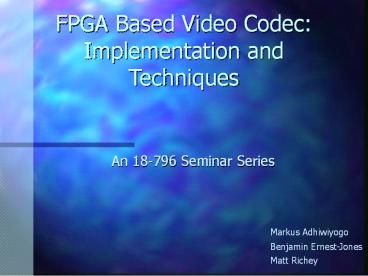FPGA Based Video Codec: Implementation and Techniques - PowerPoint PPT Presentation
Title:
FPGA Based Video Codec: Implementation and Techniques
Description:
QCIF Resolution. 60-600 kbs. CDMA for RF-Link. Configuration One. Discrete ... Although the comparison may look 'funny' one also must take into account that ... – PowerPoint PPT presentation
Number of Views:246
Avg rating:3.0/5.0
Title: FPGA Based Video Codec: Implementation and Techniques
1
FPGA Based Video CodecImplementation and
Techniques
- An 18-796 Seminar Series
Markus Adhiwiyogo Benjamin Ernest-Jones Matt
Richey
2
Field Programmable Graphical Arrays
- Ability to reconfigure its circuitry for a
desired application or function at any time after
manufacturing - Adaptive hardware that continuously changes in
response to the input data or processing
environment - Combination of general-purpose processors and
ASICs - Quick reconfiguration time, in order of 100 ?S to
1 mS
3
Basic FPGA Design and Structure
- A myriad of Configurable Logic Blocks
- The CLBs may have functionality of either adding
or comparing two numbers
- Connection between CLBs are established through
signal controlled grid connections - Current FPGAs have more than 100,000 logic gates
4
Advantages of FPGA
- Reconfiguration ability enables performing
specific computational tasks at will - Higher flexibility for adaptive coding for
multimedia requirements such as - Bandwidth availability
- Quality of Service requirements
- Channel characteristics
- Rapid prototyping and design iteration
- Certain function implementations lead to
reduction in die area
5
Disadvantages of FPGA
- Hardware is not ASIC which can lead to
non-optimized performance and density - Reconfiguration time is longer compared to
loading software - High power consumption during reconfiguration
6
Parallel Banks Technique
- Codec implemented on 2 or more FPGAs
- Each FPGA has all parts of the codec
- Enables multiple data to be processed
simultaneously - Advantages
- Easy to implement
- Die area is not a constraint
- High data throughput due to parallelism
- Disadvantages
- Too much hardware
- Lead to non-optimized configuration
7
Compile-Time Reconfiguration
- Entire chip is configured once for the target
application - Advantages
- Easy control signals
- Disadvantages
- More than 1 FPGA may be needed
8
Run-Time Reconfiguration
- Chip is reconfigured to perform different
functions during an application
- Advantages
- Reduced Hardware
- Critical Path is small
- Disadvantages
- Reconfiguration causes significant delay (can be
compensated by partial reconfiguration) - May lead to difficulty in control system
implementation
9
Prototype Video Codec from UCLA
- Transformation scheme (i.e DCT)
- Quantization
- Entropy Coding
- No Motion Compensation performed
10
Detailed Description of UCLA Video Codec
- Utilizes RTR implementation
- Partitioned into 3 separate configuration
- Discrete Wavelet Transform, Addressing, and
Control Logic - Quantization and Run Length Coding
- Entropy Coding
- RTR uses partial reconfiguration technique
- QCIF Resolution
- 60-600 kbs
- CDMA for RF-Link
11
Configuration One
- Discrete Wavelet Transform
- Short filter with integer coefficients
- Requires 318 gates and 241 flip-flops
- Corresponds to 681 CLBs
- Addressing and Control Logic
- Correct data retrieval from RAM
- Provides access to peripheral system
12
Configuration Two
- Quantization and Run Length Coding
- Requires 2500 gates
- Addressing and Control Logic
- Same as configuration 1
- Never reconfigured
- Data from previous configuration stored in
another RAM
13
Configuration Three
- Entropy Coding
- Provides 21 lossless compression
- Addressing and Control Logic
- Same as configuration 1 and 2
- Never reconfigured
- Data from previous configuration stored in
another RAM
14
Experiment Results
- RTR provides lowest silicon area
- Partial reconfiguration decreases reconfiguration
delay by 50 on Global reconfiguration - Critical Path is 220 ns (5 MHz system)
- Load and ready time approximately 1.6ms
- Compression rate of 151 was achieved
- Independent of frame size
15
Alternate ImplementationFPGA-VSP Co-Processor
- Allows more operations
- 7 x 7 Mask 2D Filter (13.3 f/sec)
- 8 x 8 Block DCT (55 f/sec)
- 4 x 4 Block VQ at 0.5 bpp (7.4 f/sec)
- 1 level WT (35.7 f/sec)
- Max FPGA clock of 20 MHz
- Max VSP clock of 50 MHz
16
Other Notable Implementations and Techniques
- Dual FPGA, One RTR at any time
- FPGA and General Processor Co-Processing
- Systolic
- Look Up Table for transform coefficients
17
Documentations
- J. Villasenor and W.H. Mangione-Smith,
"Configurable Computing, Scientific American,
pp. 66-71, June, 1997. - J. Villasenor, C. Jones, and B. Schoner, "Video
Communications using Rapidly Reconfigurable
Hardware," IEEE Transactions on Circuits and
Systems for Video Technology, vol. 5, pp.
565-567, December 1995. - B. Schoner, C. Jones and J. Villasenor, "Issues
in Wireless Video Coding Using Run-time-reconfigur
able FPGAs, Proceedings of the IEEE Symposium on
FPGAs for Custom Computing Machines, pp. 85-89,
Napa, CA, Apr. 1995. - B. Schoner, J. Villasenor, S. Molloy, R. Jain,
"Techniques for FPGA Implementation of Video
Compression," ACM/SIGBA International Symposium
on Field-Programmable Gate Arrays, 1995.
18
Related Sites
- FPGA Based Codec Site
- www.icsl.ucla.edu/ipl
- Techniques and Implementations
- www.cs.cmu.edu/afs/cs.cmu.edu/academic/class/15828
-s98/www/index.html - www.ece.cmu.edu/research/piperench/
- Hardware Sites
- www.xilinx.com
- www.altera.com
19
Question and Answers
- How does FPGA compare to direct hardware
implementation? - Compared to video cards of today, FPGAs
performance would be slower compared to them. I
believe this is because todays semiconductor
technology is still insufficient to process FPGAs
wiring and density to be optimal. - Frame rate of the UCLA video codec?
- Frame rate of the codec depends upon which
hardware implementation used. In the
co-processing method, the frame rate is variable
(from 7-35). The pure FPGA implementation runs at
20 frames/second. Although the comparison may
look funny one also must take into account that
the pure FPGA implementation much more
simplified codec than the co-processing method. - How fast a FPGA re-configure itself?
- Initial design download is 1.6 ms. Global
reconfiguration is 3 ms. Partial reconfiguration
is 1.5 ms.































